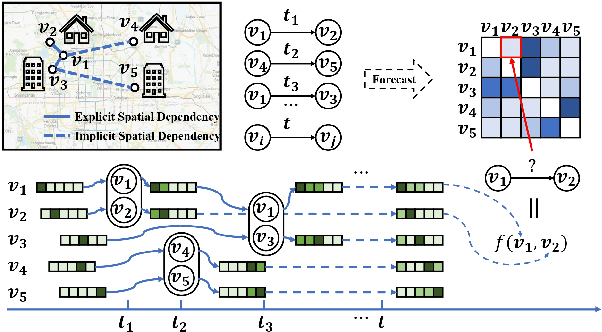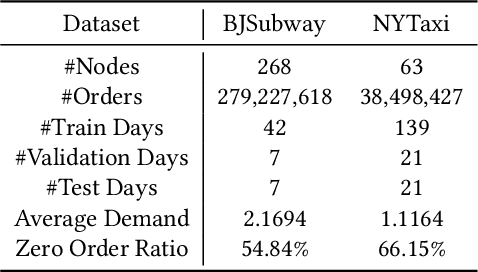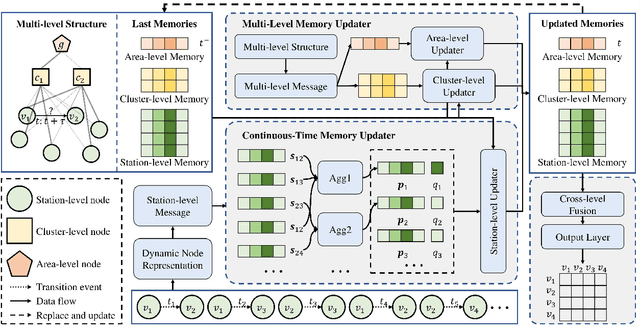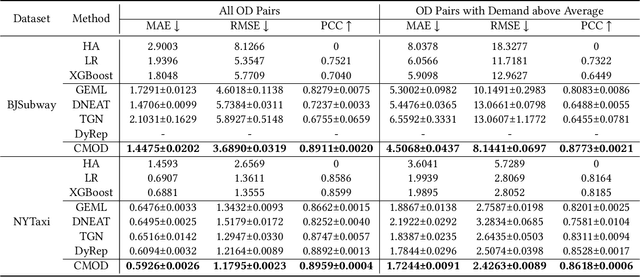Liangzhe Han
Regions are Who Walk Them: a Large Pre-trained Spatiotemporal Model Based on Human Mobility for Ubiquitous Urban Sensing
Nov 17, 2023Abstract:User profiling and region analysis are two tasks of significant commercial value. However, in practical applications, modeling different features typically involves four main steps: data preparation, data processing, model establishment, evaluation, and optimization. This process is time-consuming and labor-intensive. Repeating this workflow for each feature results in abundant development time for tasks and a reduced overall volume of task development. Indeed, human mobility data contains a wealth of information. Several successful cases suggest that conducting in-depth analysis of population movement data could potentially yield meaningful profiles about users and areas. Nonetheless, most related works have not thoroughly utilized the semantic information within human mobility data and trained on a fixed number of the regions. To tap into the rich information within population movement, based on the perspective that Regions Are Who walk them, we propose a large spatiotemporal model based on trajectories (RAW). It possesses the following characteristics: 1) Tailored for trajectory data, introducing a GPT-like structure with a parameter count of up to 1B; 2) Introducing a spatiotemporal fine-tuning module, interpreting trajectories as collection of users to derive arbitrary region embedding. This framework allows rapid task development based on the large spatiotemporal model. We conducted extensive experiments to validate the effectiveness of our proposed large spatiotemporal model. It's evident that our proposed method, relying solely on human mobility data without additional features, exhibits a certain level of relevance in user profiling and region analysis. Moreover, our model showcases promising predictive capabilities in trajectory generation tasks based on the current state, offering the potential for further innovative work utilizing this large spatiotemporal model.
Continuous-Time and Multi-Level Graph Representation Learning for Origin-Destination Demand Prediction
Jun 30, 2022



Abstract:Traffic demand forecasting by deep neural networks has attracted widespread interest in both academia and industry society. Among them, the pairwise Origin-Destination (OD) demand prediction is a valuable but challenging problem due to several factors: (i) the large number of possible OD pairs, (ii) implicitness of spatial dependence, and (iii) complexity of traffic states. To address the above issues, this paper proposes a Continuous-time and Multi-level dynamic graph representation learning method for Origin-Destination demand prediction (CMOD). Firstly, a continuous-time dynamic graph representation learning framework is constructed, which maintains a dynamic state vector for each traffic node (metro stations or taxi zones). The state vectors keep historical transaction information and are continuously updated according to the most recently happened transactions. Secondly, a multi-level structure learning module is proposed to model the spatial dependency of station-level nodes. It can not only exploit relations between nodes adaptively from data, but also share messages and representations via cluster-level and area-level virtual nodes. Lastly, a cross-level fusion module is designed to integrate multi-level memories and generate comprehensive node representations for the final prediction. Extensive experiments are conducted on two real-world datasets from Beijing Subway and New York Taxi, and the results demonstrate the superiority of our model against the state-of-the-art approaches.
Dynamic Graph Learning Based on Hierarchical Memory for Origin-Destination Demand Prediction
May 29, 2022



Abstract:Recent years have witnessed a rapid growth of applying deep spatiotemporal methods in traffic forecasting. However, the prediction of origin-destination (OD) demands is still a challenging problem since the number of OD pairs is usually quadratic to the number of stations. In this case, most of the existing spatiotemporal methods fail to handle spatial relations on such a large scale. To address this problem, this paper provides a dynamic graph representation learning framework for OD demands prediction. In particular, a hierarchical memory updater is first proposed to maintain a time-aware representation for each node, and the representations are updated according to the most recently observed OD trips in continuous-time and multiple discrete-time ways. Second, a spatiotemporal propagation mechanism is provided to aggregate representations of neighbor nodes along a random spatiotemporal route which treats origin and destination as two different semantic entities. Last, an objective function is designed to derive the future OD demands according to the most recent node representations, and also to tackle the data sparsity problem in OD prediction. Extensive experiments have been conducted on two real-world datasets, and the experimental results demonstrate the superiority of the proposed method. The code and data are available at https://github.com/Rising0321/HMOD.
 Add to Chrome
Add to Chrome Add to Firefox
Add to Firefox Add to Edge
Add to Edge